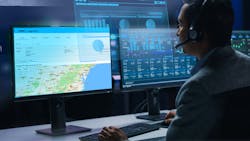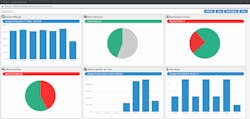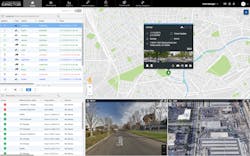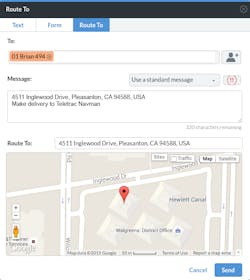Managing dozens to hundreds of trucks, trailers, and company and independent drivers takes a lot of knowledge and skills. Over the past 15 years, however, those skills have changed as technology has caught up to the complicated art of fleet dispatching. New tools and advanced technologies are helping dispatchers make better decisions that can improve a fleet's bottom line and make a driver's job easier.
“Fifteen years ago, I remember sitting in a dispatch office where I had what looked like a big desk calendar—but it was just a big pad with a grid on it,” Brent Ellis, a former dispatcher who is director of business systems and process at Decker Truck Line, told FleetOwner. “Everything to do with that business was right there on that pad on the desk. They always made the joke that if the building ever caught fire, the only things I’d have in my hand when I ran out the door were a cellphone and that pad. Because that’s all we needed, that’s all we had.”
Today, the fleet managers at Decker only need an internet connection to keep track and dispatch and monitor their fleet of nearly 800 trucks. Just earlier this century, drivers would have to call in to report when they picked up a haul. That haul would be written down on a card and dropped on Ellis’ desk so he could add the information to that giant pad of paper. “We’ve gone from that to nobody really even takes a call for a pickup anymore,” he said. “And there’s no calling the driver to tell him, ‘Hey, here’s where you need to go next.’ It’s all completely automated. It’s really not hard to believe that it happened; it’s just the timespan that it happened so quickly. And it’s snowballed into what it is now from what it was when it began.”
At the turn of the century, dispatchers were tied to their phones, taking calls from drivers on the road. “Now it’s all automated. As soon as a driver empties his load, if he’s preplanned, the system will automatically send a dispatch to him,” Dwight Bassett, president of Boyd Companies, told FleetOwner. “What we try to do—either through our load board or even the manual way—is preplan them before they empty their current load so as soon as they hit their empty macro, they get [details on] their next load.”
More time, more information
Former dispatcher Oswaldo Flores remembers the time-consuming process that came with the job, which included printing each bill of lading. “I’m talking probably 12 years ago or so,” he told FleetOwner. “I would literally get those printed off, look at the addresses, and then have to go and sift through each one and determine how best to put them together so they were dispatched somewhat in order and somewhat close to each other. I was doing that manually. It took hours and hours to do that and then give that over to the drivers to have them do the work accordingly.
“Going from those days to the solutions that are available today has been incredible,” said Flores, who is now Teletrac Navman's marketing and product manager for transport, safety, and compliance. “You literally download work orders into a dispatch management tool. And the tools nowadays are so advanced that they have algorithms, which provide information: It’s traffic, when they need to be delivered, who needs to deliver them. And it adjusts them accordingly and ranks them according to which stops should be first and last.”
Alabama-based Boyd Cos., which operates Boyd Bros. Transportation and WTI Transport, has a mobile communications unit in each of its 1,000 trucks. That unit is how drivers and dispatchers now exchange information. “In addition to that, we get GPS locations, and that’s the primary way we communicate with our drivers over the road,” Boyd’s Bassett said.
Boyd’s company drivers also all use the McLeod Software driver app, which can dispatch drivers. “Our owner-operators also have the option of going to our load board, where they can pick their own freight,” Bassett said. “So they can actually dispatch their own freight. They can on the load board, pick from what’s there, then that load will get dispatched back to them.”
Once the owner-operators get dispatched to haul the freight they choose, they just have to enter their departure and arrival information into their mobile communication unit. As long as drivers are entering in the correct information through their unit or McLeod app, “a dispatcher may go weeks without actually having a phone conversation with them,” Bassett said. “So that frees up a lot of time for the driver.”
This also cuts down on driver distractions as they're operating on the road. “It also lets our dispatchers become more like business owners,” he explained. As Boyd dispatchers keep an eye on their fleets, they know exactly how much revenue each driver makes on a daily basis. “We can analyze payroll events and see how well guys do on things like fuel mileage and look at idle time. We get a ton of safety information now. We expect our dispatchers to manage their fleet like it’s a business.”
Today’s dispatchers can be more nimble as they manage those businesses, according to Teletrac Navman’s Flores. With so much live information available, dispatchers don’t have to do a lot of research to make decisions on the fly. The former dispatcher said this helps them make better decisions.
“They know where the driver is right now, where he is heading, what the next stop is in proximity to where he should be, and what stop could be fit in between now and then,” Flores said. “Those types of dispatching tools help seamlessly organize all that information for them and be able to push it out to the drivers.”
Decker’s Ellis got into the transportation world 27 years ago as a dockworker for an LTL fleet. He later became a driver, clocking more than a million accident-free miles, before taking a fleet management job. After some time working for a brokerage company and McLeod Software, he returned to the carrier side of the industry. “I’ve done a little bit of everything transportation-wise,” he said. “I’ve pretty much seen [everything] from beginning to end—from the dock to financials to the whole nine yards.”
At Decker, which primarily runs reefer and flatbed, Ellis now oversees the fleets’ McLeod suite of software and its integrations with other third-party operations products used by Decker. The Fort Dodge, Iowa-based fleet was founded in 1931 and now has 750 trucks and six terminals in four states.
Dispatching evolution
The evolution of dispatching technology has “absolutely made us more efficient,” Ellis said. Gone is the big gridded pad he used to guard with his life. Now, about 80% of Decker’s business comes via electronic data interchange (EDI). “The load is automatically entered in the system with all the information,” he explained. “Our load planners can see everything on a load board that can be filtered based on outbound zone, inbound zone, state, cities—however they want to see it.”
Fleets are becoming more efficient as these technologies grow, according to Sherry Wu, product marketing manager at Samsara. “There are two key areas where we see the most efficiency gains: streamlined job or route assignments and increased driver productivity,” she told FleetOwner.
“Dispatching technologies can save dispatchers time by making it easier to match the right driver to the right job,” Wu explained. “This is especially true if dispatching software is integrated with real-time data from vehicle telematics, ELDs, and trailer trackers. By giving dispatchers centralized visibility into real-time GPS data, drivers’ HOS, vehicle diagnostics, dormancy, and live-to-the-second ETAs alongside upcoming loads, fleets can optimize order planning and streamline dispatching workflows by eliminating the need for multiple tools.”
EDI and other machine-to-machine interfaces that organize order entries are helping fleet managers better understand their decisions, according to Robert Brothers, VP of product development at McLeod Software. Technology, such as what McLeod provides to carriers, can create rules within the computer systems that help those fleets meet their companies’ goals.
“The computer can help apply the business rules for you,” Brothers told FleetOwner. “And when they don’t apply the business rules like you want them, you have an alert mechanism inside the operation that says, ‘Hey, you just took a load from Kansas City at $1.27 a mile. What’s that about?’ Maybe you still needed to take it, but let’s have a conversation before you pick it up. Once you pick it up, you can’t go back. And if you’re looking at it 30 days later and someone asks, ‘Why the hell did we take this for $1.27 out of Kansas City?’ It’s done. Nobody can do anything.”
“The decision-support side of things is really what our business is about,” he continued. “We still have to have systems to enter orders, properly rate them, print the freight bill, collect the dollars, pay the drivers—all the things you need to do accurately and timely.”
Helping drivers succeed
Making drivers more efficient comes with giving them helpful technology, Samsara’s Wu notes. “Drivers should be able to see upcoming assignments, navigate to their next stop, and be notified when they are making stops out of sequence,” she explained. A well-designed mobile app should give drivers the right information at the right time. This helps reduce back-and-forth between the driver and dispatch, helping both parties save time.”
One of Samsara’s customers, KeHE Distributors, saved nearly 1,000 hours per year by eliminating manual check calls for arrivals and departures, Wu said. "By empowering drivers to execute jobs, dispatchers can save time and uphold quality customer service.”
Products such as McLeod’s LoadMaster integrates into a fleet's dispatch operations management systems and allows carriers to customize dispatch solutions for their business. Those customizations can include trip management and enable drivers to select the load and lanes they want to haul.
Once a carrier has the freight order, managers and dispatchers have a decision to make. “How do you match that to your network or your drivers’ preferences and promises you made them when you hired them,” Brothers said. “Our systems really allow you to take in a lot of that information and then make recommendations. It’s a decision support: Can this driver feasibly take this load based on their hours [of service], based on their home time, based on their equipment, and based on their certifications? These are all the decision support points we help the customers make.”
The next step, Brothers said, is the actual operation of that load. “You got a driver, you got a truck, you found a trailer, which are all problems in and of itself,” he explained. “But once you find that, then you need to execute that load efficiently. You need to capture any detention time that you may have. That makes your whole ecosystem more efficient. Carriers don’t really make their business on detention charges—where they make their business is making sure their driver gets out first. And their driver might get out first because they charge detention, and they monitor for it, and they hold their customers accountable for it. So the customer knows they need to get that carrier’s driver out—because if we don’t, we’re gonna have a $200 detention charge.”
Efficiencies
This ties into creating the most efficient routes for individual drivers and loads, such as making sure drivers are being sent closer to their homes or avoiding areas of the country they don’t like to operate. And those efficient routes can also look deeper into the future to make the fleet more efficient.
“For example, they can see a balance map that shows them that next Wednesday I have 13 loads delivering in the Chicago market, but I only have seven coming out,” Decker’s Ellis said. “So I need to go and find six more loads in Chicago to get those trucks out of there. Or vice versa, they may see that I’ve got 27 loads coming out of Indianapolis next week, but I only have seven loads delivering there, so I’ve got to figure out how to get trucks close to that market to figure out how to get those loads picked up.”
This all adds efficiency to the planning side, he said. Because those future loads are also preassigned to the driver, the driver knows where he’s going next after delivering his current load. “Obviously, that can change,” Ellis noted, “but at least it keeps the driver in the loop so he’s aware of what his next several days look like.”
McLeod’s Brothers noted that “hundreds of variables” still go into dispatching efficient carriers. “But what we want to do is automate as many of those decisions as we can, provide guidance, and then let the users handle the harder situations,” he said. “So you can grow with fewer people. That’s what everybody wants to do: They want to be able to add five more trucks without adding another dispatcher. There are different economics if adding five more trucks means you also have to hire another dispatcher.”
Samsara’s Wu adds: “When routes become more optimized and more efficient, drivers can make better decisions in the field, and they’re able to do more with less—whether it’s less time spent in traffic or less time manually calling dispatch for reroutes and more time making stops and deliveries.”
Decker’s dispatching system, which uses a combination of McLeod, Geotab, and Transflo technologies, automatically updates arrival and departure times for delivered and picked-up loads. It then sends a driver to the next pickup after a load is delivered. “There’s no human interaction on that side,” Ellis pointed out. “He just continues about his day because he knows where he is going next.”
All the driver has to do is press a button on the truck’s telematics device, which uses GPS to find the most efficient route to that next pickup.
With less need for regular contact with drivers, the fleet managers’ job is freed up so he or she can focus more on unexpected problems for the driver, such as heavy traffic, inclement weather, or unexpected road closures. “That’s primarily what the fleet manager handles now rather than constantly dispatching and completing loads in the system and this and that,” Ellis said. “With an integrated telematics system, it’s amazing how little there is to do from a manual standpoint. It’s created a ton of efficiency over the past decade.”
About the Author
Josh Fisher
Editor-in-Chief
Editor-in-Chief Josh Fisher has been with FleetOwner since 2017. He covers everything from modern fleet management to operational efficiency, artificial intelligence, autonomous trucking, alternative fuels and powertrains, regulations, and emerging transportation technology. Based in Maryland, he writes the Lane Shift Ahead column about the changing North American transportation landscape.





